Polina Plotnikova creates beautiful, often painterly, flower portraits and still-life studies. Here she talks to Tracy Calder about the magic of previsualisation and the joy of working in a studio
It’s already been a long day for Polina Plotnikova by the time we sit down to chat over Zoom. The award-winning photographer was recently invited to join the assessment team at the Royal Photographic Society and has spent much of the day learning how to grade visual art panels.
‘It’s very different from all of my previous experience of judging,’ she smiles. Polina is very much in demand and looking at her beautiful, perfectly executed flower photography it’s easy to see why.
The balance of energy and precision in her work is perfectly suited to her bubbly, highly analytical nature. Each picture is flawless, and yet fizzing with life. Photography has been part of Polina’s story since she was 12 years old. ‘My first camera wasn’t that reliable – it was Russian-based technology, although Russian optics are very popular now,’ she laughs.
Having achieved a degree in the History of Art at Moscow State University she went on to work for various museums and galleries managing submissions, curating exhibitions and dealing with image collections. To quench her thirst for knowledge, she later travelled to London where she spent a year studying modern art.
‘I was dealing with absolute masterpieces,’ she reveals, ‘contemporary photographs, paintings and fine art.’

Purple cyclamen shot with a Lensbaby Twist 60 against sparkly craft paper to get a bokeh effect. Canon EOS R, Lensbaby Twist 60, 1/60sec, ISO 400
Practise previsualisation
Polina’s background in fine art can be seen in her painterly flower and still-life studies. ‘I have one series of images shot in the style of the Old Masters and another that’s a homage to my favourite Impressionists,’ she explains. ‘I’m not trying to create an image that pretends to be a painting but I use my knowledge and love of art history when visualising my pictures.’
This idea of previsualisation is central to Polina’s work. A self-confessed ‘control freak’, she loves working in the studio where every element can be tweaked until it matches the vision she has in her mind’s eye. Sometimes she will draw sketches featuring objects she plans to use, colour schemes or lighting ideas.
‘It’s important that I am 100% responsible for whatever is going on in front of my camera,’ she stresses. ‘Other photographers – whose work I greatly admire – take joy in showing an element of serendipity in their work, but that irritates me no end! I love it when the most spontaneous-looking movement in my pictures is actually something I have created deliberately.’

Red Anthurium flowers shot with a Lensbaby Burnside 35 with vignetting slider to create more mystery
Reveal the less obvious
Polina clearly enjoys creating compositions from scratch, with all the infinite possibilities this presents, but I’m curious to know if her approach to flower photography changes when she ventures outdoors. ‘No,’ she laughs. ‘I apply the same approach. I don’t go out hoping to find pictures, I still have a preconceived idea.’
But working with preconceived ideas surely creates additional challenges in the studio, because you can’t rely on a burst of sunlight or fortuitous natural combinations of plants. ‘Yes, the final result is entirely in your hands,’ she agrees. But even in the studio, nature can be unpredictable and Polina still has to remain relatively flexible, especially when it comes to flowers.
‘If you rely on your preconceived idea too much you may struggle to find the shape of flower that you have in mind because, unfortunately, nature is not under your control,’ she laughs. ‘If I could change that I would!’ Polina approaches her flower photography in a similar way to traditional portraiture. Each flower is examined to identify its unique character and personality, after which she attempts to draw out something hidden or less obvious.

Above: Apple of Peru seed head, part of Polina’s Past Perfect panel for the RPS Canon EOS 5D Mark II, 100mm, 1/125sec at f/13, ISO 100
‘It’s like circled feedback between you and the subject,’ she explains. While each flower specimen is unique, she uses her preconceived ideas to help shape the final image. ‘I might put a flower in front of the camera and notice the light doesn’t work from a certain angle, but because I have an idea in my mind I can adapt quickly,’ she reveals.
As fans of ikebana (the Japanese art of flower arranging) will know, you can’t force a plant to twist or turn to suit your needs; you have to work with what you’ve got. ‘Yes, forcing flowers into position can look artificial,’ agrees Polina. ‘You could say that still life is artificial by default, but you are still exploring the way that objects behave in front of the camera. You are looking at the relationship between light, shape and texture, for example.’
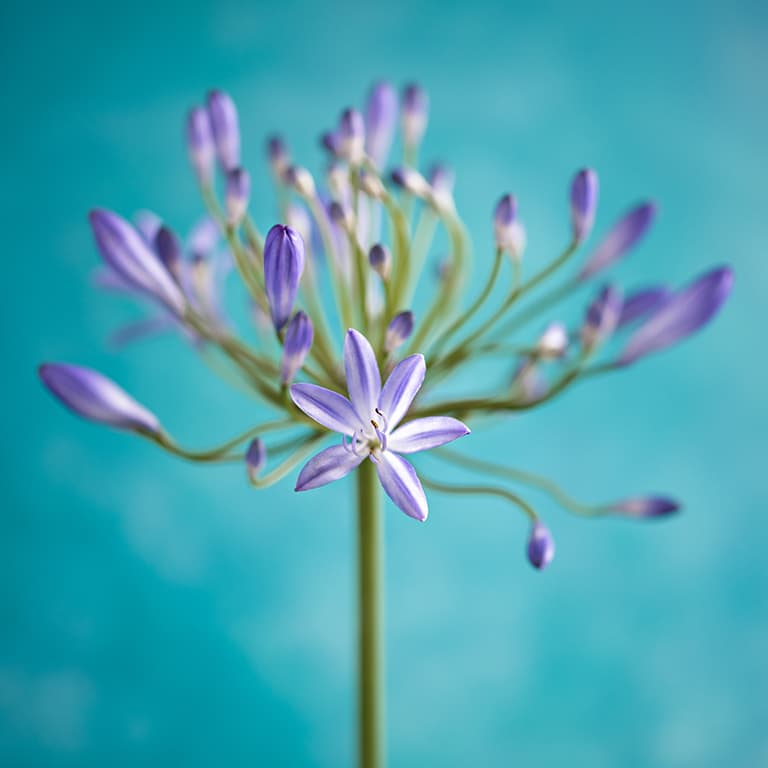
Study in blue of Agapanthus flower. Shot with continuous light and reflectors. Canon EOS R, 100mm, 1/30sec at f/2.8, ISO 200
Work with what you’ve got
Polina’s mastery of light is first-rate. Drawing on her fine art background she uses natural and artificial sources to convey mood and emotion. Whether she’s using her continuous lighting (from Interfit) or her beloved Bowens flash heads, she stresses that the most important thing is getting know your equipment.
‘Whether I use flash or continuous light usually depends on the kind of depth of field I’m after. If I’m using a Lensbaby or a macro lens wide open I won’t be able to use my Bowens, even at the lowest power, for example, so it’s about finding the right balance.’ To modify her light – creating shadows or highlights – Polina uses softboxes, umbrellas, honeycomb grids, filters, reflectors and diffusors; anything that might help her to communicate a story.
When I ask Polina about her home studio she rolls her eyes and laughs. ‘Home studio is a bit of a glorified name, because it’s actually just my study,’ she reveals. ‘Although my husband claims it’s his music room!’ It’s so refreshing to see what can be achieved in a relatively small, shared space.
‘Flowers and still-life arrangements aren’t particularly space demanding,’ Polina assures, ‘so don’t be put off by big words like “home studio”, because a spare room will do just fine. Ideally you want natural light coming from two sides, but just work with what you’ve got.’
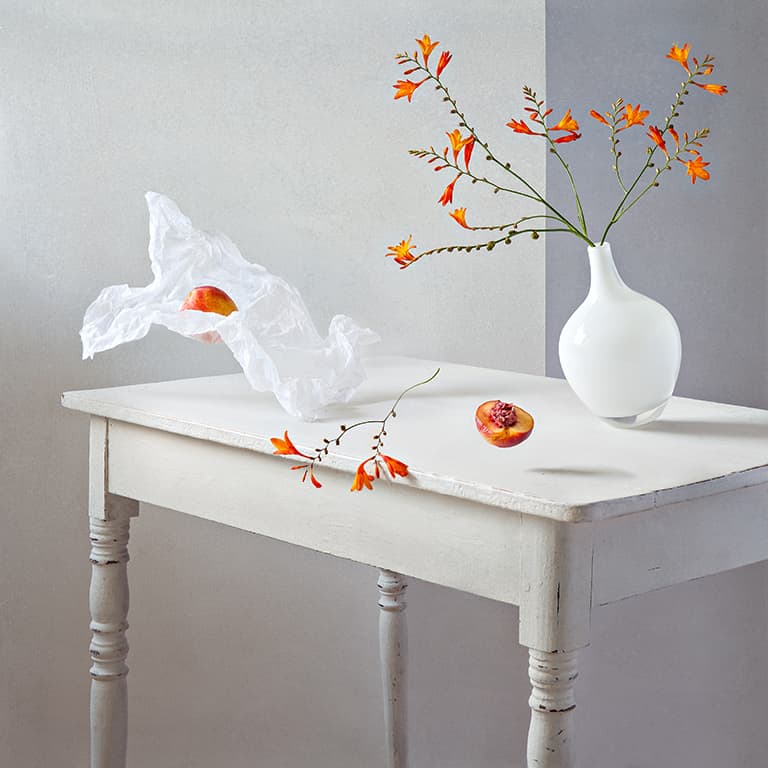
Unstill Life series. Natural light with an additional reflector
Canon EOS 5D Mark II, 24-70mm, 1/4sec at f/8, ISO 125
Spend your time wisely
As our conversation draws to a close, Polina says something that really hits home. ‘I don’t press the button until I see the perfect picture on my screen.’ While she does use Photoshop – and points out she’s not ‘one of those purists who say you should get everything right in-camera’ – she prefers to spend time with her camera rather than her computer.
‘If I can find a physical thing that will help me to achieve an effect I’m after, rather than using Photoshop, I will,’ she explains. By way of an example, she describes taking a piece of crystal and holding it in front of the camera to create interesting light effects. The subject of ‘getting it right before you release the shutter’ comes up again as we discuss backgrounds.
When she’s teaching, Polina tends to use shop-bought versions designed for studio photographers. ‘Don’t buy them all in one place though, because you will end up with pictures that look like everyone else’s,’ she warns. To be on the safe side, Polina advises using patterns that imitate nature rather than anything too bold or eye-catching.
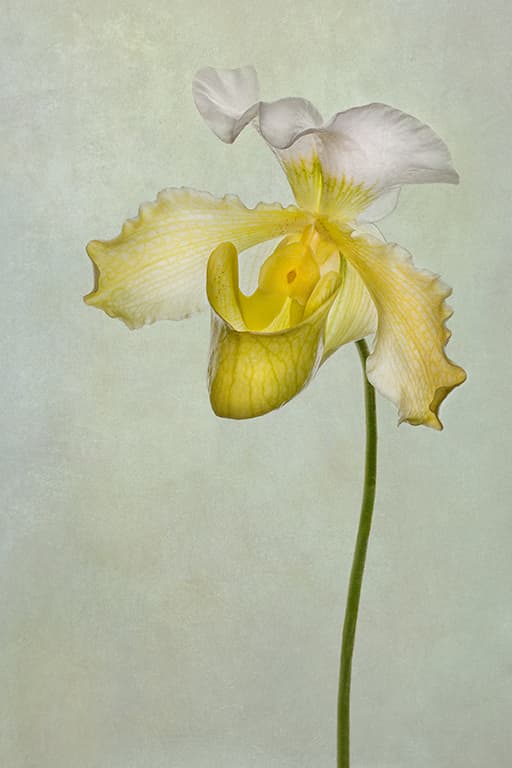
Paphiopedilum orchid portrait, shot using continuous light with a few diffusers and reflectors to eliminate shadows
Canon EOS 5D Mark II, 100mm, 1/250sec at f/13, ISO 100
If you want something bespoke, however, Polina recommends creating your own backgrounds. ‘To do this I take a digital capture – it might be a multiple exposure or abstract image using Intentional Camera Movement – then work on it in Photoshop and print it out on matt paper, around A3 size. I then have the option of painting over parts of it with acrylic paint, pencils or pastels.’
This backdrop is then used behind flowers or still-life studies. (Polina also takes a digital shot of the final backdrop so she can use it later as a layer in Photoshop).
Finishing our call before Polina becomes totally Zoomed out, I’m struck by the dedication she has to her craft.
Whether she is capturing flowers, dancers or dolls (her new obsession) she applies the same level of passion and perfectionism to the job – and her willingness to go that extra mile really shows. Polina Plotnikova is currently running several workshops at www.tradesecrets.live.

Polina Plotnikova
Polina specialises in still-life studies and flower portraiture. With numerous distinctions and photography awards to her name, she draws on her background in fine art to make images that match the vision she has in her mind’s eye. Visit www.polinaplotnikova.com.
Polina’s kit list
Canon EOS 5DS R
Polina currently uses a Canon EOS 5DS R for most of her studio work, but often uses a Canon EOS R when teaching and travelling. One thing she always looks for in a digital camera body is a decent multiple exposure mode.
Lensbaby Composer Pro with Sweet 50 Optic
Using a Lensbaby allows Polina to create special effects in-camera rather than relying on Photoshop. It also gives her the opportunity to ‘visually think outside the box’ while still having plenty of control. When pushed, she recommends a Lensbaby Composer Pro with Sweet 50 Optic.
Tweezers
When you need to adjust folds in fabric, petals or small leaves, a pair of tweezers (or similar) can be invaluable. ‘Sometimes your fingers, as careful as you are, are not going to do the job,’ says Polina.
Canon EF 100mm f/2.8L Macro IS USM
Having recently acquired a Canon 50mm f/1.2L lens, Polina has been seriously impressed by the quality, but for flower portraiture and still life she still finds her Canon EF 100mm f/2.8L Macro IS USM lens hard to beat.
Manfrotto 190CXPRO4 (or similar)
It’s useful to have a tripod with a central column that can be positioned at 90°, such as the Manfrotto 190CXPRO4, but when it comes to the head choice Polina isn’t fussy. ‘I recently switched to a ball head with two levers because my wrists have become a little weak,’ she reveals.
Polina’s top flower photography tips

Take your time
‘Flowers are perfect models: they don’t fidget, you don’t have to provide them with a lunch break, and they don’t check their Instagram every five minutes,’ laughs Polina. So, take your time and try to draw out something hidden or less obvious from your subject.
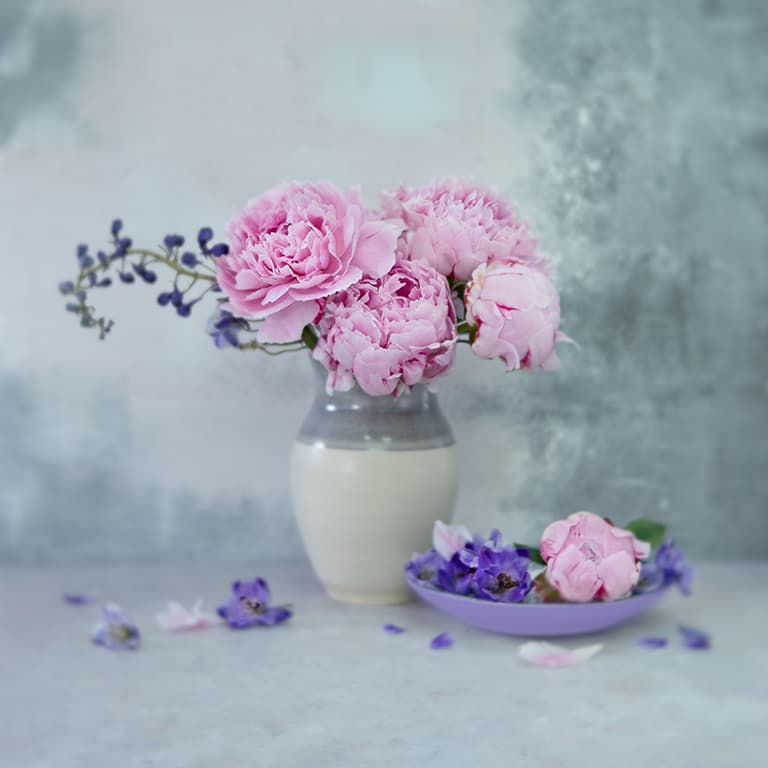
Get to know your gear
‘So many people on my creative flower photography workshops watch me demonstrate a technique and then say, ‘I don’t think I can do that with my camera.’ I then show them they can,’ explains Polina. ‘A lot of people are still neglecting to read the manual!’

Backlighting without the cost
‘If you want to shoot backlit flowers, but you don’t have a studio light, then consider using a diffusor in front of a window on a bright day. Place your subject in front of it and then use a reflector (or piece of tin foil) to reflect light back onto the subject.’
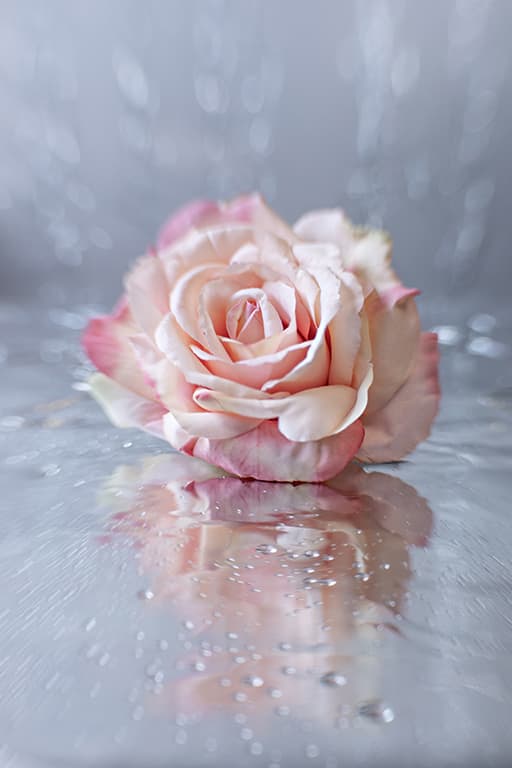
Raid the Christmas box
Whether you want to create bokeh, rain or a natural sun-kissed look, you might find that you have everything you need in the house already. For this image the rose was placed on a sheet of tin foil, with a rail of tinsel strands behind it, and then sprayed with a plant mister.

Try tethering
‘Tethering the camera to the laptop helps me to see things in a two-dimensional format,’ says Polina. ‘When I look through the viewfinder, I am effectively still seeing a three-dimensional image (whatever I see with my eyes), which makes it harder for me to spot any imperfections.’

Think portraiture
When you’re photographing flowers, think like a portrait photographer and try to bring out individual characteristics. Don’t try to force a plant into an unnatural position – it’s better to respond to what’s in front of you and then tweak your technique accordingly.
Further reading
How to shoot close-up flowers








